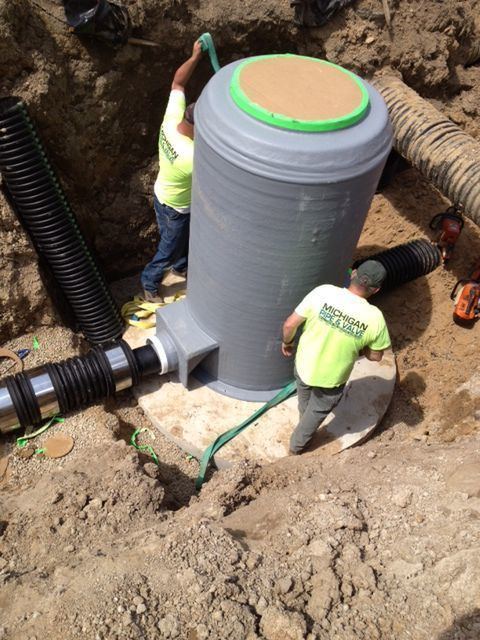 | ||
Packaged metering manholes (PMMs) are an outgrowth of the fiberglass manholes developed by a division of Owens Corning (now Containment Solutions, Inc.) in the 1960s. Packaged metering manhole factories integrate a primary device (typically a flume or weir) into a fiberglass manhole.
Contents
The result is a lightweight, single-piece (generally), corrosion resistant structure from which an operator can measure piped flows, take composite samples, and perform water quality parameter monitoring.
Benefits
Manufacturers of packaged metering manholes cite the following benefits:
Limitations
The nature of the construction of packaged metering manholes brings a number of limitations not commonly found with pre-cast concrete structures.
These include:
Components
At its simplest, a packaged metering manhole consists of:
Manhole barrel
The fiberglass barrels used in the production of packaged metering manholes are, almost exclusively in North America, required to meet the standards set for in ASTM D 3753: Standard Specification for Glass-Fiber-Reinforced Polyester Manholes and Wetwells. The standard sets out minimum performance criteria, quality control, chemical resistance, and materials of construction.
Typical manhole barrel thickness is 3/8-inch to 1/2-inch [ [0.9525–1.27 cm] thick. Thickness is assumed to be solid barrels only (not including any exterior ribbing). For manhole barrels with ribbing laminated to the exterior of the barrel, the barrel thickness is allowed to be thinner than otherwise would be allowed under ASTM D 3753. The typical breakpoint between solid and ribbed barrels occurs at the 72-inch [1.83 m] diameter. Below 72-inches [1.83 m] and the barrels are solid wall. Above it and the barrels have exterior ribbing.
Top
Since their introduction, a variety of different top styles have been developed for packaged metering manholes.
These most common of these are:
In addition to these more common styles, a variety of custom tops have also been developed by various manufacturers, including: open tops, grating platforms, split top, and restricted access covers.
Primary device
When used to measure open channel flows, packaged metering manholes most commonly integrate a flume or weir (flumes being most common due to their ability to pass solids, low head loss, and wide operating ranges). Parshall flumes are most commonly integrated, followed by Palmer-Bowlus flumes, although Cutthroat, Montana, Trapezoidal, and H Type flumes can also be integrated. Weirs are less commonly integrated due to their poor solids handling characteristics as well as the inability to develop a sufficiently large upstream weir pool.
For piped flow applications, several manufacturers offer magnetic flow meters factory integrated into a packaged metering manhole structure.
Base
In order to form a watertight unit, a packaged metering manhole is provided with a solid fiberglass base at the bottom of the manhole barrel. The base can serve not only as the bottom of the manhole, but also as a means of anchoring the manhole to a concrete slab (required to counteract the buoyant forces on the manhole).
Cost
For primary devices where the device (and proper transitions) can be molded into the manhole barrel, the unit cost of a pre-cast manhole is lower than that of a packaged metering manhole (although they lack the corrosion resistance and factory water-tightness of a packaged metering manhole).
Larger primary devices (and transitions) that do not readily fit into a standard 4-foot [1.22 m] pre-cast manhole barrel, either a larger barrel or a concrete vault must be used – adding cost. The packaged metering manhole, on the other hand, can integrate primary devices that are larger than the manhole barrel – with any portion that doesn't fit inside the manhole barrel extending upstream / downstream as necessary. Those portion that extend upstream / downstream of the barrel are manufactured with integral covers and laminated into the manhole structure. It is this ability to incorporate primary devices larger than the manhole barrel that can allow a packaged metering manhole to be as, or better, cost effective than a pre-cast manhole / vault.
Packaged metering manholes can run from $5,195 to $29,100 (2016 USD), with the industry typical 4-foot diameter, domed top packaged metering manhole, 7-feet-deep integrating a 3-inch Parshall flume having a cost of $10,565 (2016 USD).
Manufacturers
Packaged metering manholes are most prevalent in the United States (with occasional installatiins in Canada and Mexico). As such, the majority of manufacturers are located there.
While there are a number of resellers (manufacturers representatives, supply companies, etc.), there are three primary manufacturers of packaged metering manholes in North America.
Listed alphabetically, these are:
Internationally, Armatech Environmental, located in New Zealand, also manufactures packaged metering manholes for Oceana;
The primary limitation to the wider distribution and use of packaged metering manholes is the high (relative to product cost) of shipping the units overseas.
